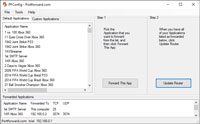
- #REVIEWS OF PORT FORWARD NETWORK UTILITIES SOFTWARE HOW TO#
- #REVIEWS OF PORT FORWARD NETWORK UTILITIES SOFTWARE SOFTWARE#
- #REVIEWS OF PORT FORWARD NETWORK UTILITIES SOFTWARE PASSWORD#
However this is a security risk and you should change the NMK from the default. This means that adding adapters to an existing network is easy as the new adapters have the same NMK as the ones already on the network. Some manufactures will ship adapters with a common NMK.
#REVIEWS OF PORT FORWARD NETWORK UTILITIES SOFTWARE SOFTWARE#
Note: On Older adapters (AV1) don’t have a share/security button to initiate the paring process you may need to program each adapter with the same key using the software utility that comes with the adapter. Note: the adapters will remember this key even if they are unplugged from the mains. The two adapters should locate each other and agree a shared key. You then do the same with the other adapter. The basic idea is that you put one of the adapters in a receptive mode where it listens for another adapter trying to establish a connection. If they don’t automatically establish a connection then you will need to intervene and manually initiate pairing. This means that when you plug them into your mains socket they will establish a connection between themselves, and form a logical network. Normally you buy adapters in pairs, and the manufacturer will normally ship each pair with a common NMK. To build a powerline network you need at least two homeplug adapters. This key is used to encrypt the data on the network using 128 bit AES (AV2 standard) or 56 bit DES (AV1 standard).
#REVIEWS OF PORT FORWARD NETWORK UTILITIES SOFTWARE PASSWORD#
To overcome this powerline adapters form logical networks based on a security key or password called a NMK (Network Management Key). This means that in a neighbourhood of houses that all use powerline adapters there is a potential security risk. Powerline adapters share the same physical media (the mains cable). Having a basic understanding of how the powerline network works is crucial to troubleshooting problems, and for building,repairing and upgrading them. Note: Coexist means that they do not interfere with each other when plugged into the same mains wiring system AV,AV2 and HomePlug Green PHY are fully interoperable but at the speed of the lowest speed adapter.HomePlug AV 200 works with homeplug AV 500M but at the lower speed.HomePlug AV can coexist on same cable with Homeplug 1.0 adapters, but will not work with homeplug 1.0.Homeplug 1.0 works with HomePlug 1.0 Turbo (85 Mbps).

Generally homeplug 1.0 devices will only work with other homeplug 1.0 devices, and Homeplug AV,AV2 and HomePlug Green PHY will all work together, but will not work with Homeplug 1.0 devices. You will probably face inter operability issues when you need to add another adapter to an existing network or replace a faulty adapter. HomePlug Green PHY -low power version and low speed.Homeplug AV2 (latest) Maximum speed currently 1200Mbps.Homeplug AV speeds 200Mbs speeds of 500Mbps are now available and marketed normally as AV500.It is important to be aware of the different standards because of potential inter operability issues. Powerline standards have evolved since the initial homeplug 1.0. To provide wireless range extension using a powerline Wi-Fi booster.To connect a device to the network that requires a high speed and reliable connection e.g.To connect devices to a home network that are out of range of the wireless router.Long range and not affected by thick walls and other obstacles like Wi-Fi.Fast speeds of 500Mbps are possible with new models.Can use Powerline adapter to power the device e.g.The power line adapter then plugs into the mains, and uses the mains wiring to transmit the data.Īnother power line adapter is required somewhere on the same mains cable system to extract the signal. Powerline networking utilizes your existing mains electrical cable to connect devices together.ĭevices like computers plug into a powerline adapter using an Ethernet cable with a UTP connector, just like they would plug into an Ethernet hub or switch.
#REVIEWS OF PORT FORWARD NETWORK UTILITIES SOFTWARE HOW TO#


HomePlug adapters are typically used to connect non Wi-Fi equipped devices to a home network, and to extend the range of existing networks. Note: HomePlug is the family name for power line specifications for networking over existing home electrical wiring. That is the idea behind Powerline or Homeplug networks. Instead of running new Ethernet cables to connect your devices to your home network then why not use your existing electrical power cables?


 0 kommentar(er)
0 kommentar(er)
